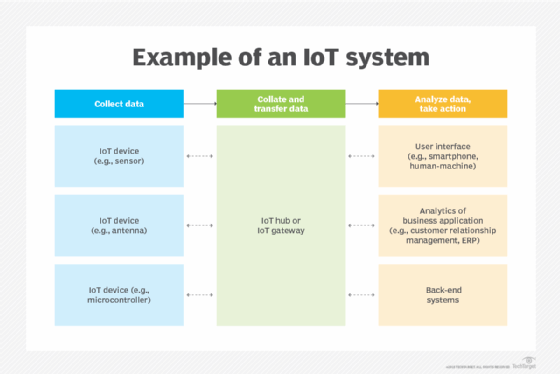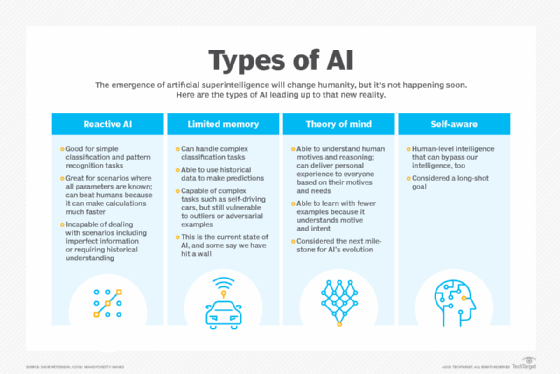AI and IoT: How do the internet of things and AI work together? (original) (raw)
AI can compound the benefits of IoT by adding human-like awareness and decision-making to the environment at hand to ultimately increase efficiency and improve processes.
IoT and AI are two of the hottest topics in tech, which is a good reason why enterprise technologists must understand them. The two technologies can be highly symbiotic, so it's critical to plan for how they can support each other to benefit enterprise users.
What is IoT?
IoT is a network of devices rather than people. IoT applications are normally built from devices that sense real-world conditions and then trigger actions to respond in some way. Often, the response includes steps that influence the real world. A simple example is a sensor that, when activated, turns on some lights, but many IoT applications require more complicated rules to link triggers and control elements to manage processes in real time.
The messages that represent triggers and actions or commands in IoT flow through what's commonly called a control loop. The part of an IoT application that receives the triggers and initiates the actions is the center point of that loop and the place where IoT rules reside.
The control loop is only a part of the total information flow in an IoT application -- the part that receives information on real-world process conditions and generates real-world responses. Most IoT applications also generate some business transactions. For example, the reading of a shipping manifest at the entry to a warehouse might open the gate for the driver -- a control loop decision -- and generate a transaction to receive the goods represented on the manifest into inventory -- a business transaction. Decisions made in the control loop must meet application latency requirements, which are often referred to as the length of the control loop.
Often, control loops only require simple processing to close the loop and create a real-world response to an event. Entering a code to open a gate is an example of this. In other cases, the processing needed to decide is more complicated. When the processing must apply more decision factors, the time required to make these decisions can affect the length of the control loop and the ability of IoT to provide the features expected. A half-minute delay in having a worker scan a manifest before admitting a truck into a freight yard, for example, could reduce yard capacity. IoT could read a QR code on the manifest and make the necessary decisions much faster, speeding the movement of goods.
AI sensors can create mountains of data, much of which has immediate value in process control and value in the sense of business analysis and optimization. AI can be used in both these missions, and proper AI usage can increase efficiency and accuracy. But not all AI is the same, and not all types are applicable to a given control or analysis mission. Figure 1 illustrates the elements of an IoT application and their relationship to other business applications.

Figure 1. An example of how an IoT system works from collecting data to taking action
What is AI?
AI is a class of applications that interpret conditions and make decisions, like the way people respond to their senses, without requiring direct human intervention.
There are four broad forms of AI in use today, ranging from simple and almost mechanical to complex and almost human:
- Simple or rule-based AI is software that has rules or policies that relate trigger events to actions. These rules are programmed, so some people might not recognize this as a form of AI. However, many AI platforms rely on this strategy.
- Machine learning (ML) is a form of AI where the application learns behavior rather than having it programmed in. The learning can take the form of monitoring a live system, relating human responses to events and then repeating them when the same conditions occur by either analyzing past behaviors or having an expert provide the data.
- Inference or neural networks use AI to build an engine that is designed to mimic a simple biological brain and make deductions that generate responses to triggers based on what the engine infers the conditions are. Today, this technology is applied most often to image analysis and complex analytics.
- Generative AI, popularized by ChatGPT, builds a knowledge base by examining millions of online documents and then answers plain-language queries based on that knowledge and a set of rules provided by engineers. The breadth of the knowledge base and the sophistication of the rules that govern queries can make this form of AI seem human, and it represents the state of the art for many involved in the field.
All these forms of AI are designed to stand in for human intelligence, but their ability to represent something even approaching human intelligence is greater as you progress through the four in the order above. It's also possible to classify AI systems based on the way they progress toward intelligence, as the Figure 2 shows. Most AI experts would say that the current state of AI art, and all the current forms of AI listed above, fall in the leftmost two types and that the goal of AI experimentation is to advance toward the right.

Figure 2. AI categorized into four types, beginning with the task-specific intelligent systems.
How can IoT and AI support each other?
In IoT, real-world events are signaled and processed to create an appropriate response. In a simple sense then, any IoT application that uses software to generate a response to a trigger event is at least a basic form of AI, and AI is then essential to IoT. The question for IoT users and developers isn't whether to use AI, but how far AI can be taken. That depends on the complexity and variability of the real-world systems IoT supports.
Simple, rule-based AI would say, "If trigger switch is pressed, turn on light A," and a more sophisticated evolution might say, "If trigger switch is pressed, and it's dark**,**turn on light A." This represents not just event (trigger switch) recognition, but also state (it's dark) recognition. Programmers use state/event tables to describe how a series of events are interpreted in multiple states, but this only works if there are a limited number of states that can be easily recognized.
The application of inferential AI mechanisms, ML and generative AI demands a source of knowledge, as well as a rule set. Generally, control loop applications in IoT are handled using little beyond ML for the simple reason that the time required to perform more complex analysis is outside the range of required response times.
Reasonably simple AI tools can enhance control loops. Referencing the example of a truck arriving at a warehouse with goods to store, simple AI could provide a means for the driver to enter a code to pass through a security gate. This would eliminate the cost of hiring a worker to attend the gate. It's also possible to read a barcode or RFID tag on the vehicle itself and allow access without the entry of a code. This would allow the truck to keep moving as its right to enter was validated, further speeding the process. Analyzing the bill of lading could offer greater benefits in directing the truck, and AI analysis of resources and time required to unload and/or load a vehicle could also be beneficial in moving goods more efficiently.
If more conditions must be analyzed to determine a response to an IoT event, the process falls outside the capabilities of the simple AI application. If the "it's dark " state was substituted with one called "I need more light" and the IoT system was to respond not to a specific trigger switch but to the task a person was trying to perform, simple AI wouldn't be enough.
In that situation, the ML form of AI might monitor the arrival of a truckload of goods at the warehouse. Over time, it could learn when the drivers and workers needed more light and activate the switch without the person needing to act. Alternatively, an expert might perform the expected tasks and teach the software when more light would be appropriate. AI and ML software would then eliminate the need for a programmer to build each IoT application.
In the inference form of AI, the IoT application attempts to gather as much information as possible, mimicking what a person senses. It then applies inference rules, such as "people can't work where light levels are below x ," and, from the conditions sensed and the application of those rules, decides to turn on a light. The challenge with this level of AI and with generative AI in control loop applications is the delay that they could introduce. Generally, it's best to try to separate analysis steps from control loop steps.
Inference-based AI requires more complicated software to gather conditions and define inference rules, but it can respond to a wider range of conditions without being programmed. The same level of inference processing could determine whether additional workers should be assigned to unloading because the goods are critically needed, the work is getting behind schedule or simply because workers are available. All this could improve the movement of goods and the overall efficiency of truckers and warehouse personnel in our warehouse example and could bring similar benefits to other missions.
AI beyond the control loop
Most control loop elements require only simple rules, and development may resemble programming more than AI engineering. Applications of IoT that examine historical data to make decisions are more likely to be related to planning than to real-time process control, and for these applications, more sophisticated AI tools, including inference engines and generative AI, may be appropriate.
While there's been a lot published on the value of generative AI, most is based on the use of tools that exploit internet-wide knowledge bases rather than private user-collected data. Because the latter is most likely to be valuable in IoT applications, current generative AI stories may not be useful in assessing whether these tools could be valuable in IoT. In fact, it could be difficult to differentiate between generative AI tools used with locally created knowledge bases and ML or inference AI tools already in common use in analytics. Prospective users should keep this in mind and be sure they're not responding more to market hype than to real benefits in adopting generative AI for IoT missions.
Conclusion
IoT is about using computer tools to automate real-world processes, and like all automation tasks, it's expected to reduce the need for direct human participation. Although IoT is aimed at reducing human work, it doesn't eliminate the need for human judgment and decisions. That's where AI can step in and improve the IoT system significantly, providing that the capabilities of the AI tools are an advance over simple IoT programming and controllers and providing that the use of AI doesn't introduce delay in the control loop that could compromise real-time control.
As AI improves, meaning it more closely mimics human capabilities, the contribution it can make to IoT applications will be greatly expanded. Because the field is developing rapidly, IoT users should monitor AI developments closely and watch for new opportunities and symbiosis.
 Nvidia, SoftBank claim AI, 5G telecom pilot first
Nvidia, SoftBank claim AI, 5G telecom pilot first  By: Joe O’Halloran
By: Joe O’Halloran  Server manufacturers ramp-up edge AI efforts
Server manufacturers ramp-up edge AI efforts  By: Cliff Saran
By: Cliff Saran  Beyond IBM Watson: A Computer Weekly Downtime Upload podcast
Beyond IBM Watson: A Computer Weekly Downtime Upload podcast  What is AI inference?
What is AI inference?  By: Sean Kerner
By: Sean Kerner